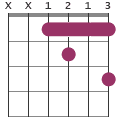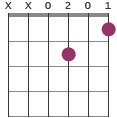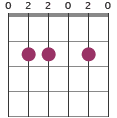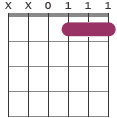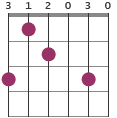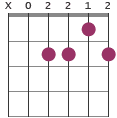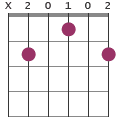Minor 6th chords
The Minor 6th chord is a four-note chord that adds the sixth degree note in the major scale to the minor triad. By comparing Cm with Cm6 we can see that the notes changes from C, Eb, G to C, Eb, G, A. The minor sixth chord can be a substitute for a common minor, but can sound somewhat dissonant depending on the musical circumstances (it diverges from the relevant musical key).
Minor 6th chords
Cm6
Dm6
Em6
Fm6
Gm6
Am6
Bm6
Comments
These are, generally, chords in open position, with Cm6 as an exception which is a closed chord (having no loose strings). Also noticeable is that Cm6 and Fm6 are played with alternative bass notes, see different versions below. Fm6 can be played with the root note in the base by using the thumb on the sixth string and muting the fifth on the same time. Em6 can also be played as 042000.
Minor 6th with flats and sharps
Additional chords in this category:
C sharp / D flat m6: 678696
D sharp / E flat m6: XX1312
F sharp / G flat m6: XX4645
G sharp / A flat m6: XX6867
A sharp / B flat m6: 688686
Theory
The minor 6th chord can be found on the ii degree in a major scale. In C major, this would be Dm6 whereas Em9 and Am9 would be non-diatonic chords because of the C# and F# notes, respectively.
Chord formula
The minor sixth is built with the formula 1-b3-5-6 (root, minor 3rd, perfect 5th and major 6th).
Chord construction
Cm6 x - x - Eb - A - C - GDm6 x - x - D - A - B - F
Em6 E - B - E - G - C# - E
Fm6 x - x - D - Ab - C - F
Gm6 G - Bb - E - G - D - E
Am6 x - A - E - A - C - F#
Bm6 x - x - D - G# - B - F#
Guitar versions of the chord
Notes in chord
Cm6 C - Eb - G - ADm6 D - F - A - B
Em6 E - G - B - C#
Fm6 F - Ab - C - D
Gm6 G - Bb - D - E
Am6 A - C - E - F#
Bm6 B - D - F# - G#
The intervals are 1 – b3 – 5 – 6
Movable minor 6th chord
The Minor 6th can be played as a barre chord. The diagram below shows a barre shape based on the Em6 shape with the root note on the 6th string.
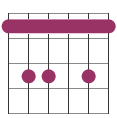
To play, for example F#m6, the short notation is: 244242.
Voicings with bass note on 6th string
Here is a movable voicing for the minor sixth with the root on the lowest string.
Fm6: 1X0111
Gm6: 3X2333
Am6: 5X4555
Bm6: 7X6777
Cm6: 8X7888
Dm6: 10 X 9 10 10 10
Em6: 12 X 11 12 12 12
Voicings with bass note on 5th string
If you want to play the minor sixth with the bass note on fifth string, here are some voicings. Notice that the two shapes are movable. Concerning Gm6, Am6 and Bm6 the root note is not the same as the bass note.
Cm6: X31213
Dm6: X53435
Em6: X75657
Fm6: X86768
Gm6: X55756
Am6: X77978
Bm6: X 9 9 11 9 10
Voicings with bass note on 4th string
Voicings for the minor sixth with the bass note on fourth string. Notice that the two shapes are movable. Concerning this movable shape, the root note is not the same as the bass note.
Gm6: XX2333
Am6: XX4555
Minor 6th chord in open position
Here are additional fingerings in open position for this chord category:
Em6: 042000
G#m6/D# / Abm6/Eb7: XX1101
Am6: X04210
Bbm6: X1302X
Bm6: X20102
Chord progressions
Here are chord sequences that include the minor 6th:
G6 - Am6 - Bm7
Am - F - Dm6 - E
Amaj9 - Bm6 - D6 - E
G - Dm6 - E7 - Am7 - D7 - G
Am - Am(Maj7) (X01220) - Am7 - Am6 - Fmaj7 - E7
Am6 (5X455X)- G13 (3X345X) - Cmaj7/E (03245X)
Notice that the Dm6 fits well before E7 since both include a B note, which Dm doesn't. In the second progression, Amaj9 can be played as X02100.
Minor 6th chords work as ii, but not as iii and vi chords (atonal). So, for example, in C major key, Dm6 is an viable (diatonic) option. This is the reason for this chord category to be less used compared to minor seventh.
Minor 6th chord inversions
A minor 6th chord is possible to play in numerous configurations including three inversions (it's also common to combine inversions with omitting notes for this chord type).
Cm6 can be used as an example:
- C - Eb - G - A (root position)
- Eb - G - A - C (1st inversion)
- G - A - C - Eb (2nd inversion)
- A - C - Eb - G (3rd inversion)
To indicate that a chord is played inverted it is written as slash sign before the bass note. For example, the first inversion of the Cm6 chord is written Cm6/Eb. Some examples follow below in short notation:
Cm6/Eb: XX1213
Cm6/G: 30101X
Cm6/A: X01013
Dm6/E: 000201
Dm6/F: 100201
Dm6/B: X20201
Em6/G: 322020
Em6/B: X22020
Em6/C#: X42000
Fm6/Ab: 430111
Fm6/C: X30111
Fm6/D: XX0111
Gm6/Bb: X10030
Gm6/D: XX0353
Gm6/E: 010030
Am6/C: X34210
Am6/E: 002212
Am6/F#: 202210
Bm6/D: XX0102
Bm6/F#: 220102
Bm6/A: X00102
For more chord diagrams, see The Chord Reference ebook.
